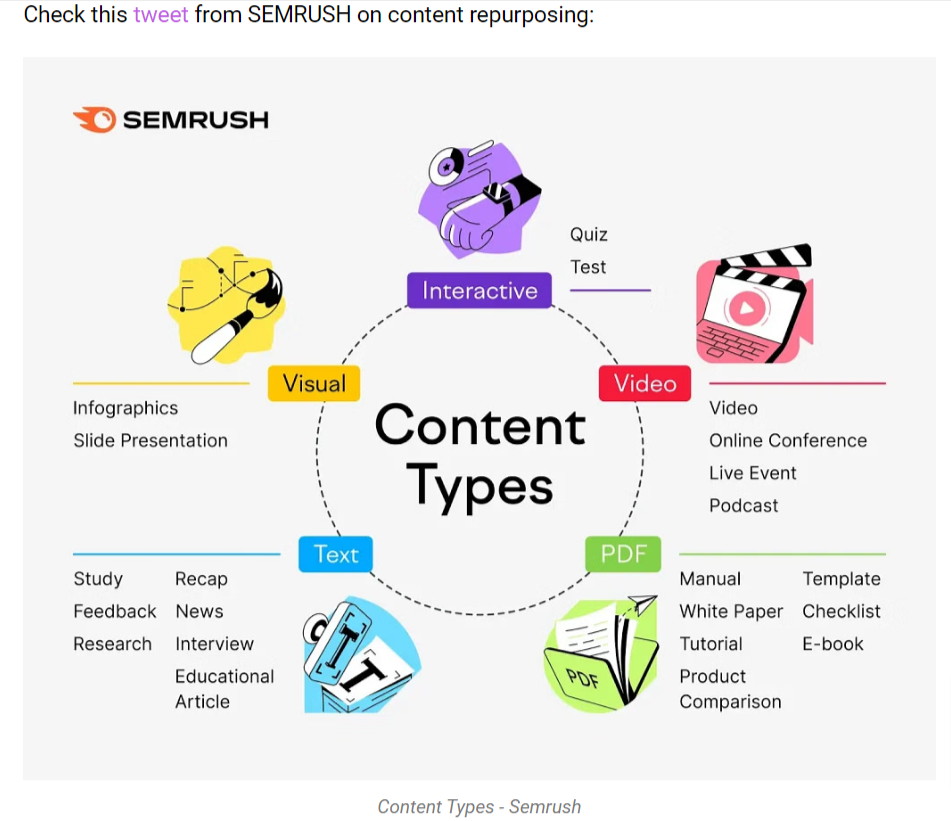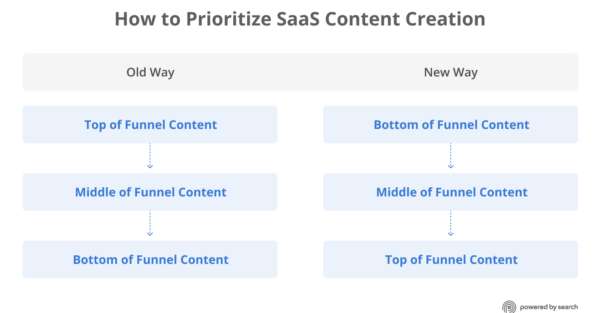How to Repurpose Content for B2B SaaS Marketing
Last updated: May 16th, 2024
Repurposing content is the best way to breathe new life into your existing content and maximize its impact across multiple platforms. This is well-known in the marketing world, but the question is how to do it so it aligns with your content strategy, and this is exactly what we’ll discuss here.
We’ll delve into content repurposing by outlining the benefits and explaining how to repurpose your content so you can get more mileage out of it. Let’s get started.
Why Repurpose Content?
Repurposing content or content syndication means taking an existing piece of content and transforming it for a different platform. The content is often heavily adapted and turned into a different type of content. For example, turning a blog post into a few tweets or a podcast episode into a blog post.
As you can see, this isn’t just about reposting the same content but reimagining it to make it fresh and engaging, and putting it into a completely new context. So, let’s see some of the benefits that come with repurposing content.
Scale Your Content Production When Nurturing Leads
SaaS sales cycles are long, and leads require significant nurturing along the way, which can mean a lot of content. Content repurposing allows you to scale rapidly to meet the need for a high quantity of content. And 42% of marketers agree that repurposing content leads to higher content marketing success.
Expand Your Content Reach
Repurposing content allows you to target audiences on different platforms using a different media type. For example, by turning content from a blog post into a YouTube video, you can connect with audiences across different platforms where video content is consumed. This boosts brand awareness and increases engagement with your content.
Prevent Content Creation Burnout
With repurposing, you can produce more content at a quicker pace. It’s efficient because you’re reworking what you already have and not developing everything entirely from scratch.
This approach saves time and energy, and helps to prevent burnout from having to develop fresh content frequently. It also benefits small businesses that need to create a high content output with a small team.
Good For SEO
By repurposing content and publishing it on different channels, you’re not just reaching more eyes, but you’re also enhancing your SEO. This strategy allows you to target different keywords, create backlinks, and increase engagement through social shares, improving your visibility in search results.
When to Repurpose Content?
Here are some guidelines to help you understand when to ideally begin repurposing content.
- You have a ton of content already.
- Some of the content is old and less relevant.
- Some of the content was highly successful and could lead to a repeat of that success.
- You’re limited in time or capacity to create fresh content.
- You’re expanding onto a new channel and need to familiarize the audience with your brand.
- Your content portfolio is heavy on one format, such as blog posts, but light on others, like videos or social media posts.
- You want to strategically target leads at different stages of the marketing funnel.
When these scenarios ring true, it’s a green light to start transforming your existing content to serve your current needs and goals.
How to Repurpose Content Correctly
Start by defining your intention for repurposing content. Are you trying to boost brand awareness, increase user engagement, or nurture leads along the sales funnel? This will ensure that every new piece aligns with your content marketing goals.
With that settled, here’s how to repurpose content effectively.
Leverage Evergreen Content
Evergreen content is any content that remains relevant and isn’t tied to a specific time or trend. Still, this content can lose its initial appeal over time, so repurposing it can give it life again and reignite interest. This is particularly relevant if it initially garnered significant attention and engagement.
Select the Best-Performing Content
Utilize analytics to identify content that has historically resonated with your audience, marked by high engagement rates or organic reach. This content has proven its value, so repurposing it is a way to extend its lifecycle and maximize its impact.
Make Repurposing a Part of Your Content Creation Process
Repurposing content is often more of an afterthought when you’re out of ideas or can’t create fresh content. However, you can also make it a part of your content creation schedule.
When developing fresh content, think ahead to how you can adapt it for other platforms. Aim to develop a set number of repurposed content out of each new piece and include it in your content schedule.
Adapt for the Chosen Platform
Each platform has different types of content and audience preferences, so be sure to adapt your content to fit the chosen platform. For example, you can take a long-form blog post and turn it into several shorter social media posts. Alternatively, you can turn multiple blog posts into an informative ebook or a YouTube video.
Monitor and Evaluate
Of course, don’t forget to monitor your content to ensure it achieves the intended purpose. Keep a close eye on comments and engagement with your content to find opportunities to delve deeper into the topic or repurpose it into another format.
Republishing vs Repurposing
Republishing is not the same as repurposing. Republishing involves reposting old content on the same platform but with updates to keep it current. Common updates include altering time-sensitive details, like product prices, or updating event dates and times. This will keep the content relevant and engaging for new and returning visitors.
B2B SaaS Content Repurposing Ideas
There are a lot of options and ways to repurpose SaaS content. For B2B SaaS businesses, repurposing content can be a strategic move to target leads at different stages of the marketing funnel to guide them through to sales.
Here are several ideas for repurposing SaaS content that might inspire you:
- Turn client testimonials into remarketing content for SQLs
- Use sales “battlecards” to develop competitor comparison articles
- Develop shorter video content from customer onboarding videos
- Create infographics from product or performance data
- Adapt how-to articles into YouTube videos
- Turn blog posts into email newsletters
- Roll several blog posts into an e-learning course
- Write a guest post based on your original article
- Chop a podcast into several blog posts and social media posts
The additional benefit is that all of this repurposed content can link back to the original content to give you more backlinks.

Align Your Content to the Sales Funnel for Best Results
Ultimately, as a B2B SaaS company, you should align your content to your sales funnel.
The traditional approach to SaaS content creation involves developing top-of-funnel content. However, this is an inefficient approach because you invest too much time developing content for leads that are less likely to convert.
Instead, you should focus first on developing content specifically for leads at the bottom of the funnel. Then, focus on middle of the funnel leads, and finally, those at the top of the funnel. It’s important to align your content to the sales funnel because the content that will appeal the most differs from one stage to the next.

Bottom of the Funnel
Leads that have reached the bottom of the funnel share the characteristics of having high buying intent and high conversion rates. But, they are also searching for specific terms with a low search volume.
These leads are most likely either solution-aware or product-aware. This means they know they have a problem, they know the possible solutions, and may also know about your product.
The types of content that are likely to appeal to BOFU leads include:
- Comparison pages
- Product pages
- Case studies
- Pricing pages
- Product demo videos
- Webinars
Middle of the Funnel
Middle of the funnel leads have neither a high buying intent nor high conversion rates. These leads are at an indecisive stage where they are problem-aware and have begun to research the various solutions but are not yet qualified to have a serious conversion with sales.
At this point, the content should get them in the position where they imagine themselves using your product.
Content suitable for MOFU includes:
- Interactive tools
- Product tour pages
- Case studies
- Newsletters
Top of the Funnel
Leads at the top of the funnel are searching for terms with a high search volume and are, therefore, easier to reach, but there’s low conversion potential. This user is at the very start of the marketing funnel and may not even be problem-aware yet.
The goal for content at this stage is to introduce your brand and provide value to gradually guide these leads down the funnel.
The types of content best used to target TOFU include:
- Listicles
- Guides
- Reels and short videos
- Social media posts
- Roundup posts
- Lead magnets
- Opinion and thought leadership
Wrapping Up
As you can see, repurposing content has many benefits, including greater brand visibility and reduced creativity burnout. But, the overall benefit of repurposed content is the scalability it brings to a SaaS business.
If you want to get a headstart on the competition and find out how scalable your business is right now, try our SaaS scalability score self-assessment. This assessment looks at how well you currently attract, engage, and convert customers. It will highlight areas for improvement and get the ball rolling for growth.
What you should do now
Whenever you’re ready…here are 4 ways we can help you grow your B2B software or technology business:
- Claim your Free Marketing Plan. If you’d like to work with us to turn your website into your best demo and trial acquisition platform, claim your FREE Marketing Plan. One of our growth experts will understand your current demand generation situation, and then suggest practical digital marketing strategies to hit your pipeline targets with certainty and predictability.
- If you’d like to learn the exact demand strategies we use for free, go to our blog or visit our resources section, where you can download guides, calculators, and templates we use for our most successful clients.
- If you’d like to work with other experts on our team or learn why we have off the charts team member satisfaction score, then see our Careers page.
- If you know another marketer who’d enjoy reading this page, share it with them via email, Linkedin, Twitter, or Facebook.